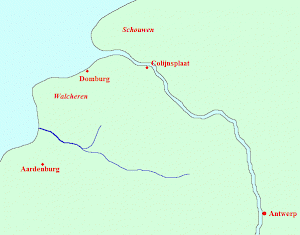Scaldis (Scheldt)
Q37620Scaldis: river in the west of the Roman province of Gallia Belgica. The modern English name is Scheldt, but it is locally known as Escaut (French) and Schelde (Dutch).

The origin of the Scheldt is in northern France, just north of Saint-Quentin (ancient Augusta Veromanduorum). Flowing north through the territory of the tribes of the Nervians and Menapians, it first passes Cambray (Camaracum) and Valenciennes, where it receives the waters of the Selle, a minor river that was once known as the Sabis: the place where the Roman general Julius Caesar in the summer of 57 BCE defeated the Nervians.
Just north of Valenciennes, at modern Escautpont (ancient Pons Scaldis), is and was the bridge in the road that connected the capital of the Nervii, Bavay (Bagacum), with the Menapian town of Tournai (Turnacum). Passing along the last-mentioned town, the river turns to the northeast and reaches modern Antwerp, makes a turn to the northwest and finally empties itself - some 350 kilometers from the source - into the North Sea. Nowadays, there are two estuaries. They are called the Western and Eastern Scheldt, although "Southern" and "Northern Scheldt" are better descriptions of their actual positions.

In Antiquity, the Eastern Scheldt was the only branch: the geographer Ptolemy of Alexandria knows only one estuary, which he calls Tabula.note The Western Scheldt used to be a minor river, flowing into the sea south of modern Vlissingen, but in the Merovingian age, the sea broke along this stream and reached the Scheldt, thus giving the river a second mouth, which has widened over the ages. Nowadays, this Western Scheldt is the main outlet.
Still, there may have been a second branch in the Roman age. In his account of an attack on the Menapians in the spring of 53, Caesar tells that the Scaldis joined the Meuse.note This suggests that there was a minor branch, because the Eastern Scheldt empties itself directly into the sea. However, there is no geological evidence to confirm this statement, and Caesar's account is probably wrong.
Close to the sea were the two sanctuaries of Nehalennia near Colijnsplaat and Domburg; their ancient names are not known, although it is likely that Colijnsplaat is identical to a town called Ganuenta. North of the Eastern Scheldt may have been the land of the Frisiavones, although we are not really certain about this again. The problem is, of course, that the landscape in this part of the Netherlands, called Zeeland, has changed very much since Antiquity.
 The Eastern Scheldt at Colijnsplaat |
 Colijnsplaat, reconstructed temple of Nehalennia |
 The Western Scheldt near Vlissingen |
 The Western Scheldt near Vlissingen |